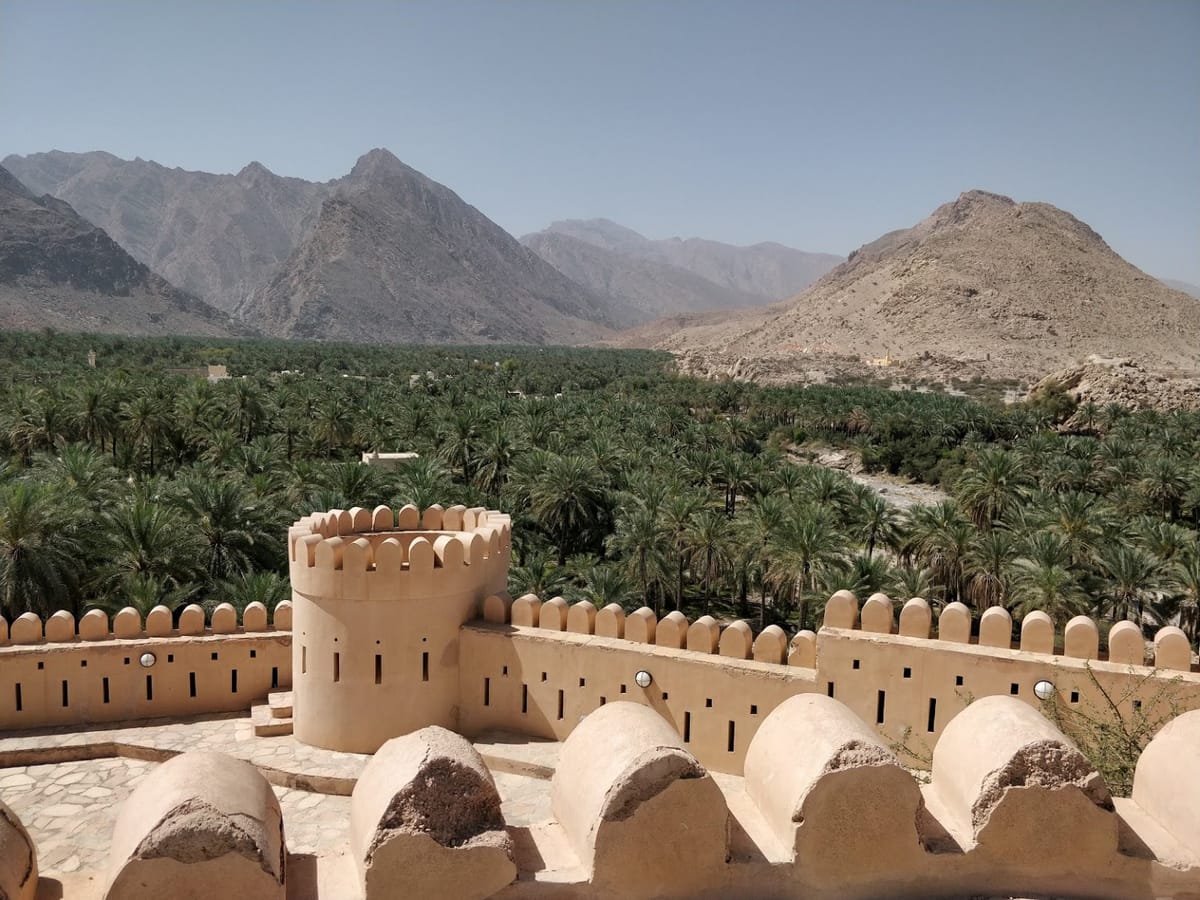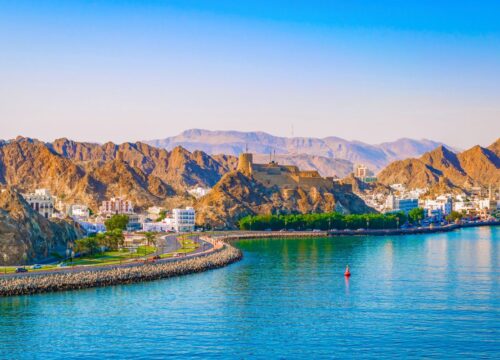AD DAKHILIYAH
Explore Tours
A’Dakhiliyah Governorate occupies a distinctive location on the
western slopes of Al Hajar Mountains (the slopes of Al Jabal Al Akhdhar)
towards the desert in the south.
A’Dakhiliyah Governorate has played a role of great significance in Oman’s
history, particularly with regard to the spread of Islam in Oman. Nizwa, the
capital of Oman in the early days of Islam, was the cradle of ardent
intellectual activity and produced generations of Omani scientists, scholars
and historians. That’s why it has been called “the egg of Islam”. Its towering
historic castle still stands today as well as many forts, castles, ancient
mosques and other beautiful tourist sites. Nizwa District is also famous for
its many old houses.
A’Dakhiliyah Governorate has played a significant role in linking the coast
to the interior of Oman, as it was the main trade route and the meeting
place of caravans for many centuries.
Ad Dakhiliyah Governorate consists of eight provinces (wilayat):
• Nizwa
• Samail
• Bahla
• Adam
• Al Hamra
• Manah
• Izki
• Bid Bid
Included/Exclude
Tour Amenities
Tour Plan
| Time | ACTIVITY |
| 7:00 AM | DEPARTURE |
| 8:00 AM | Visit Al Figayn Fort in Manah |
| 10:00 AM | Roam around the historical Nizwa souq |
| 12:00 NN | Visit Nizwa Fort |
| 2:00 PM | Picnic and lunch at Falaj Daris |
| 4:00 PM | Visit Bayt Ar Rudaydah Castle |
| 5:30 PM | Back to hotel |
BAYT AR RUDAYDAH CASTLE
Bayt Ar Rudaydah dates back to the seventeenth century. It lies about
24 kilometres from Nizwa in A'Dakhiliyah Governorate, at the entrance
of Wadi Al Muaydin. The Castle combines the defensive and traditional
elements of architecture, as its thick walls, topped with towers
constructed of brick clay, hide an architecture elegance that is revealed
in the shape of multiple arches, painted ceilings and elaborate plaster
engravings.
Bayt Ar Rudaydah Castle has been converted into a heritage weapons
museum which displays the historical progression traditional weapons in
Oman.
NIZWA FORT
Nizwa Fort (نزوى قلعة (is one of the most popular tourist attractions in
Oman due to the fact that it is an amazing example of old Omani
architecture that provides an illustration of the way Omani people used
to live in ancient times. The oldest part of Nizwa Fort was originally
constructed by imam Al Sult bin Malik Al Kharusi in the ninth century
and was later renovated by imam Sultan bin Saif Al Yarubi in the 17th
century. Imam Sultan bin Saif Al Yarubi is known as
the imam responsible for removing the Portuguese from Oman.
| Time | ACTIVITY |
| 7:00 AM | DEPARTURE |
| 8:00 AM | Visit the enchanting Al Hoota Cave |
| 9:30 AM | Passby at Bahla Fort |
| 11:00 NN | Get fascinated at Jibreen Castle |
| 1:30 PM | Lunch and shopping at Bahla souq |
| 3:00 PM | Visit Salut Archaeological site/Zakket tomb |
| 5:30 PM | Back to hotel |
Al Hoota Cave
Extending over 4.5 km (2.8 miles), Al Hoota is located at the foot of Jabal
Shams, Oman‘s highest mountain. The cave has been formed and shaped
by natural process over millions of years, creating stalactites hanging from the ceilings and stalagmites reaching up from the floor. Silence
engulfs you as you enter the cave, stepping foot into its
impressive chambers.
According to the official story, a shepherd lost his goat and stumbled
across the cave in 1960. However, legend has it that the space has been
used for centuries as an escape route and hiding spot for people fleeing
trouble. Whichever story you prefer, the cave has undoubtedly played an
important role in the lives of locals for decades.
Bahla Fort
The oasis of Bahla owes its prosperity to the Banu Nebhan, the dominant
tribe in the area from the 12th to the end of the 15th century. The ruins of
the immense fort, with its walls and towers of unbaked brick and its stone
foundations, is a remarkable example of this type of fortification and attests
to the power of the Banu Nebhan.
JABREEN CASTLE
Jabreen Castle was built by Imam Bel’arab bin Sultan Al Yarubi.
His father was Imam Sultan bin Saif Al Yarubi the Imam who removed the
Portuguese from Oman and the one who expanded Nizwa fort to its current
form. Imam Bel’arab inherited from his father a country in a period of peace
after the removal of the Portuguese. It is rumored that this palace was
actually built through the personal funding of Bel’arab during the lifetime of
his father before he became the Imam of the country. The country
experienced an era of prosperity and development through the time
of Imam Bel’arab until his brother Said bin Sultan succeeded in his scheme
to remove him in 1692.
Jabreen Castle is different from other Omani forts because it was not built
in the times of war and is not a fortification that was expanded by
different Imams overs centuries. It is basically a palace constructed in times
of peace by a ruler who was passionate about science and art and that
made it the most beautiful historic castle found in the Sultanate. The castle
is three stories tall, features two towers, numerous receptions halls, dining
areas, meeting rooms, a court room, a library, and classrooms. The interior
design of the castle features decorated windows, wooden balconies,
arches with inscribed Arabic calligraphy, and breathtaking ceiling artwork.
BAHLA SOUQ
Bahla Souq is a short distance traditional souq from Bahla Fort. It is
most famous for homemade ropes and large metal plates. It also has
many traditional industries like making daggers and copper artefacts,
in addition to Omani sweets (Halwa). This Souq is famous for its active
commercial activity, with a beautiful tree at the central courtyard. The
Road for the souq is very accessible, just head to the main Nizwa–Ibri
road, opposite to the fort; you will find the souq entrance is 100m on
the right.
SALUT ARCHAEOLOGICAL SITE/ ZAKEET TOMB
The historical significance of Salut is directly connected with the
dawn of the Omani history, which first saw the light with the arrival of Arab
tribes in Oman from different regions of the Arabian Peninsula. This site is
witness to the beginning of settlements in Oman. Salut Archaeological Site
is located on top of a rocky hill in A'Dakhiliyah Governorate.
Ruins have been found that date back to the Iron Age between the period
1,400 to 600 BC. There is no doubt that the location of Salut is one of the
most important sites containing ruins that help explore the Iron Age, whose
development in the eastern Arabian Peninsula is still not well understood .
From a historical and archaeological perspective, the site is noted for its
fortified buildings and architectural style which is impressive for that era, in
addition to the use of the Falaj Irrigation System.
| Time | ACTIVITY |
| 7:00 AM | DEPARTURE |
| 8:00 AM | Start trekking and hiking at Wadi Ghul or Grand Canyon and early luch |
| 12:00 NN | Start driving going up Jebel Shams |
| 6:00 PN | Back to the hotel |
GRAND CANYON ( WADI GHUL )
From 3,000 meters at the top of Oman’s tallest mountain, Jebel Shams, to
the flat area just below the summit, you can see 1 kilometer straight down
into Wadi Ghul, Oman’s Grand Canyon. From this area, called “the
balcony,” the drop is so far and the canyon so vast it is hard to get a sense
of scale. Rock formations and layers in the ancient rock give the canyon an
almost other-worldly feel. It is the deepest canyon in the Middle.
The Wadi Ghul is an immense dried riverbed near Jebel
Shams (‘Mountain of the Sun’), the highest peak in the Hajar mountain
range. The village of Ghul gives the canyon its current name.The
canyon is awe-inspiring and one of the country’s most famous
natural attractions, reaching in some points 1 km (0.6 miles) in
depth.Visitors come here to enjoy stunning views, breathtaking
overhangs, an abandoned village, and an idyllic oasis.
JEBEL SHAMS
Jebel Shams, translated as Mountain of the Sun, is Oman’s highest
peak. The mountain is also featured by its view into the spectacular
deep Wadi Ghul lying alongside it.
The mountain lies in the heart of the Western Hajar Mountain chain in
Al Dakhiliyah region, hosting Jebel Akhdar as well.
With views of the Al Nakhur Canyon labelled as “The Grand
Canyon” of Arabia, Jabal Shams Oman is one of the must visit
attractions for any visitor.
This is the highest peak in the Arabian Peninsula, rising to an altitude
of 3,004 metres above sea level, and has plenty of slopes and
summits. Jabal Shams is so called because it is the first place to greet
sunlight at dawn and the last to say farewell at dusk.
| Time | ACTIVITY |
| 7:00 AM | DEPARTURE |
| 8:00 AM | Enjoy at Wadi Muaydin |
| 10:00 AM | Start driving to the top of Jebel Akdhar and stay overnight and enjoy the cool breeze |
| 8:00 AM (following day) | Back to the hotel |
WADI MUAYDIN
The endlessly deep gorge, Wadi Muaydin, makes for fascinating
exploration, as it slices its way southward from the edge of the Sayq
Plateau. It is a beautiful place, and is easy walking with some minor
scrambling, rather than canyoning.
JEBEL AKDHAR
At first glance Jebel Akhdar’s name, which translates to Green Mountain,
seems misguided or even ironic. The designation encompasses the Saiq
Plateau, a massive upland of mostly barren rock sporting just a few hearty
bushes and trees, as well as the surrounding bare-sloped mountains.
However, we can help you discover hidden wadis and terraces where
apricots, pomegranates, walnuts and roses all flourish in cooler, highaltitude temperatures. Additionally, you can experience the mountains’
panoramic views, small traditional villages and rose-water distilleries
Location
Find a route from your location
Related Tours
- Quality4.33
- Location3.67
- Amenities4.33
- Services5
- Price3.67
Ash Sharqiyah North Governorate
- Quality4.33
- Location4
- Amenities4
- Services4.67
- Price4
AL SHARQIYAH SOUTH
- Quality3.67
- Location4.33
- Amenities4.67
- Services4
- Price4












4.6
It is a great place to shop not too far from New York. We took the bus from Port Authority and traveled through the countryside to get there.
4.4
This is the best tour on the east coast! It was amazing how many places we visited and what great memories we made!
3.8
We always stay at here when in town. The location is great, staff is wonderful and we love the overall feel. Beautiful view from the here.